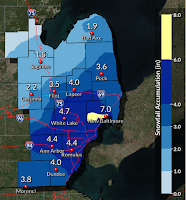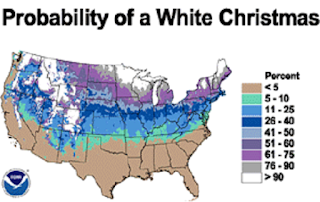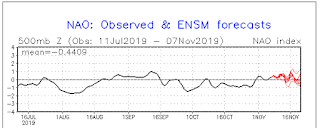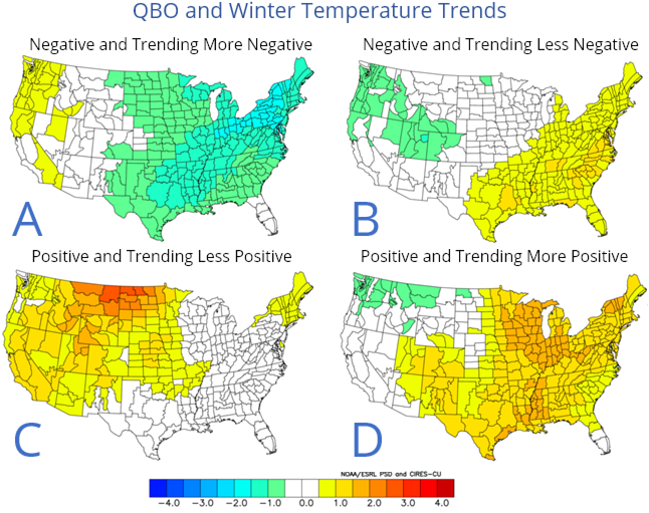Frequently during the Christmas Season, meteorologists are asked; Are we going to have white Christmas? Generally,
it is agreed among meteorologists that in order to "officially" have a
white Christmas, an average of an inch of snow must cover the ground,
but not necessarily have to fall on Christmas.
At
this time /Friday; December 20th, 2019/ the chance of a white
Christmas across all of Southeast Lower Michigan is pretty-well non-existent.
Unless some divine intervention comes along before Christmas; model forecasts are negative for even the inch of snow needed by
Christmas morning. In fact; Christmas day may very well be the warmest of the near term stretch with temperatures up into the 40s and 50s. If changes come in a blinding flash
(they have been fairly consistent) in model-land before Christmas, an
update will surely be sent! This is similar to last year /2018/ around Metro Detroit when no white Christmas was had by all and in fact; temperatures pushed up into the 40s and 50s in the few days following Christmas. Further north from the Flint area into the Saginaw Valley and Thumb Region however; a inch or two remained on the ground for a white Christmas across that region.
This entire December has been similar to last year's with scant amounts of snow but with colder temperatures thus far. This past November was also similar to last year's with colder than normal weather and above normal snow - though not as much as this November.
Over
the years, extreme Southeast Lower Michigan has averaged about a 50
percent chance for a white Christmas. Some years it's already on the
ground, some years not, some years it melts while other years it falls
on the day. However, theoretically, you could actually have nothing on
the ground Christmas morning and have a snowstorm dump a foot on the
region during the day and still have NO official white Christmas under
the standing morning rule. It works the other way too; you could have a
several inches on the ground at 7am 12/25 but warmer air and/or rain
melts it away by afternoon or evening and still officially have a white
Christmas.
Two years ago / 2017/; an unexpected white Christmas was had in spades as low
pressure system overachieved; developing robustly over the southern
Great Lake/northern Ohio Valley. The system developed into a notable
little snowstorm falling mainly on Christmas Eve over the southeast area
as seen in this map, bringing snow for a picturesque, classic Christmas
scene. The only negative - and a notable one - was the lousy driving
conditions Christmas Eve into early Christmas Day but with improving
conditions later for Christmas dinnertime.

In
2016; even with mild weather with temperatures in the 30s; Southeast
Lower Michigan was able to hold on to a white Christmas as the snow
(generally 2-5") slowly melted. In fact; the day after Christmas, warm
air surged into the region and pushed temperatures into mainly the 50s
and took care of any remaining snow! Back in December /2015/; it was a
mild and snowless Christmas with a high temperatures near 50. Of course,
the year before, /2014/ contained our record breaking warm El Nino
December, therefore the hopes for a white Christmas were low anyway.
Back on Christmas 2014, the chances for a white Christmas were very
similar to 2015 with record setting low amounts of snow for the month
(in the top 5 snowless). Officially
on 12/25/14 at 7am; no snow was on the ground with a trace of light
rain on the date. Only a TRACE of snow had fallen up to that day in
December /0.1 for the entire month/. Most areas over the remainder of
Southeast Lower Michigan had a few tenths of snow Christmas eve or
Christmas but with less than the amount needed and mild temperatures
rising into the upper 30s to around 40...none of the area saw a white
Christmas.
More Previous Christmases back to 2004:
In 2013;
even with all the snowfall throughout last winter, officially on
12/25/13 at 7am Detroit Metro Airport had only a TRACE of snow on the
ground. Most areas into the remainder of Southeast Lower Michigan had
some residual snow and ice on the ground for a white Christmas. Back in 2012,
enough snow did fall at Detroit Metro Arpt (an inch of fresh snow
Christmas Eve) to make it an official white Christmas was on the ground
as of 7AM. The necessary inch or more was also on the ground at both
Flint and Saginaw. Ironically the day after Christmas, the best
snowstorm of the winter season hit the region...a day late and several
inches short for Christmas. A year earlier in 2011, it was a relatively mild Christmas with temperatures in the 40s and no snow on the ground; so no white Christmas. However back in 2010;
residents across Southeast Lower Michigan did enjoy a white Christmas
with generally 1” to 6” of snow across as temperatures hovered in the
20s. Then further back in 2009,
much of the Detroit area south did not have a white Christmas but
points north across Flint, Saginaw and the thumb region generally had a
1” to 3” snow cover. Back in 2008, we
saw a “sloppy, melting white” Christmas. That white Christmas involved
the melting of a heavy snow cover from past snows that accumulated
throughout December. The best of the snowstorms came before Christmas on
the 19th (with another, lesser intense snow falling on the doorstep of Christmas, 23rd -24th).
After, however, the heavy snow cover melted in earnest as milder air
overspread the region Christmas Eve right through the 26th. Christmas of 2007,
saw temperatures rise into the mid 40s to mid 50s a couple of days
prior to Christmas and that, combined with light rain, pretty much took
care of any hopes for a white Christmas as then, like the later
Christmas of 2008, the previous heavy snow cover melted (but this time
in its entirety before Christmas). Some scattered light snow did return,
skirting the landscape on Christmas Eve but most areas around Southeast
Lower Michigan still only had a trace of snow for Christmas. At White
Lake and Saginaw, however, the official inch of snow to make it a white
Christmas was barely attained in 2007.
Going back further to the Christmas of 2006; it was also mild and therefore, there was no white Christmas. In 2005,
we just barely squeaked out a white Christmas (at Detroit Metro
Airport, anyway) as a mild spell moved in just before Christmas along
with rain, melting the snow down from 4” to 1” by Christmas morning.
Originally, there had been 8” of snow on the ground on the 15th. The last really scenic (no slop) with fresh white snow for Christmas occurred in 2004. A snowstorm brought heavy snow (ranging from 8”at Detroit to around 4” in Saginaw and Flint) on the 23rd, which
left the region with a nice white cover for Christmas. It was also a
cold Christmas also with highs only in the teens and overnight lows
below zero.

Looking
over historical weather records of Christmases past since 1900, a wide
range of weather conditions were found. While most people would like to
believe that Christmas in the Detroit area should be snowy-white and
picturesque, more often than not, they're not. Over the past 119
(including 1900) Christmases in Detroit, 56 (47%) have been what would
be called "white" with an inch or better of snow on the ground. Keep in
mind however, these records are for Detroit; farther north in Flint, the
chance of a white Christmas jumps to 56 percent, while in Saginaw and
the Thumb region it rises to 61 percent.
Based
on the Detroit records, the Santa award for the "whitest" (most snow on
the ground) and also the second snowiest Christmas (snow falling on
Christmas) goes to the Christmas of 1951! Just over a foot /13 inches/
of snow was recorded on ground late Christmas day with 6.2 inches of the
snow falling on Christmas. Temperatures held well below freezing
(HI-26/LOW-18), so what snow did fall, remained. A close second to the
"whitest" Christmas, occurred the Christmas after the big stock market
crash in 1929. Eleven and a half inches of snow was measured December
25th, 1929 at Detroit but only three tenths /.3/ fell on Christmas.
Recently, the Christmas of 2000 was very white indeed, but as to how
much of a white Christmas (snow depths) is where the confusion came in.
Let me elaborate, officially at Detroit Metro Airport, just six inches
of snow was recorded on the ground at 7AM Christmas Day. However, just
about anywhere west/north and in the city of Detroit itself, amounts
were considerably higher with generally 8 to at least 15 inches. At the
National Weather Service in White Lake, 15 inches was observed on the
ground Christmas 2000 morning. No additional snow fell on Christmas Day
(nor was anymore really wanted with the surplus already at hand). In any
event, for Detroit and surrounding communities, the six inches at
Detroit Metro Airport is the official snow depth used for the area.
The
snowiest Christmas (most snow falling on Christmas), occurred in 1915
when 6.4 inches fell with a snow depth of seven inches on the ground.
The timing of this snowfall was impeccable for Christmas with it
actually starting Christmas Eve around sunset. Then, it continued to
snow through the night into Christmas day. Actually, even more than the
6.4 inches fell from the entire storm with an additional 1.6 inches
falling on Christmas Eve. This gave a snowstorm total of eight inches. A
little light rain did mix with the snow during the forenoon hours of
Christmas but with a high temperature of only 33, it did little to mar
the "Christmas card" scene. Speaking of "Christmas card" scenes, another
heavy wet snowfall blanketed the area just after the turn of the
century early on Christmas in 1901. The scene is described in the
historical weather books as follows:
"Night of the 24 - 25 cloudy; moist snow continued,
heaviest between hours of 1:30 and 4:30 am, ended
at 6 am. amount of precipitation .62 inches. The
street cars ran all night to keep the tracks open.
the snow adhered to trees etc, and made a very
beautiful scene. Depth of snow on ground at 8 am,
5.5 inches".
This
"Norman Rockwell Christmas scene" was further enhanced by a heavy
coating of frost deposited on the buildings and windows Christmas Eve
due to the moisture-laden air. But just like memories of some
Christmases past, this majestic Christmas scene quickly faded (melted)
during the day as temperatures climbed to 41 degrees, leaving just slush
, slop and water. During the Christmases of 2002 and 2003, the weather
was similar to both of the white Christmases mentioned above /1901 &
1915/. Here again in 2003, snow started falling Christmas Eve and
lasted into at least part of, if not all of Christmas Day. On Christmas
Day 2003, snowfalls ranged from at least an inch in the far southeast
corner of Lower Michigan to as much as six inches across Detroit's
northern suburbs, extending northward across Flint and Saginaw. On
Christmas Day of 2002, total snowfall at Detroit Metro Airport was
measured at 6.4” inches for both days (Christmas Eve and Christmas) with
3.4” of it falling on Christmas Day, itself. Across all of Southeast
Lower Michigan snowfalls generally ranged from four to seven inches. A
picture perfect Christmas was created both years with the freshly fallen
snow. Like the Christmas snowstorms of 1901 and 1915, the snow
Christmas 2002 was also somewhat heavy and wet with high temperatures in
the lower 30s and lows only in the mid 20s.
Probably
one of the slushiest and sloppiest Christmas Days happened in 1973.
What started out as a white Christmas with a heavy 7 inch snow cover,
quickly melted to a meager 2” slush mess by nightfall. To add insult to
injury, it rained nearly a half an inch during the day.The wettest
Christmas on record occurred in 1945 when 1.16 inches of rain fell. The
rain actually began Christmas Eve as a light freezing rain and continued
freezing until nearly dawn on Christmas, when the temperature pushed
above freezing. Until the ice melted, a few tenths of an inch of ice
coated everything by Christmas dawn. Needless to say, walking and
driving early the Christmas of 1945 was treacherous but Santa was in and
out of town in a flash!
Without
a doubt, and still in the memories of long term inhabitants of
Southeast Lower Michigan, is the warmest Christmas on record, the
Christmas of 1982. It was as though the whole area was shipped to
Florida for the holiday! The official record high at Detroit was 64
degrees, while Flint did one degree better at 65! These readings are
about normal for Tallahassee, Florida! Scenes of shirt sleeved people
with shorts running or riding bikes, instead of visions of sugar plums,
made the Christmas of 1982 to some Michigan Christmas traditionalist,
very hard to take. This spring-like day was complete with scattered
showers and, of all things, thunderstorms! Ironically, the bitterest
cold Christmas came just a year later in 1983! Maybe a payback from
Mother Nature for the warm weather we were treated to, the Christmas
past? The temperature plummeted Christmas eve to a record low of -9 at
Detroit and was accompanied by a stiff west wind averaging 25 to 30 mph,
creating life threatening wind chills at times of near 40 below zero!
Santa certainly brought the North Pole with him the Christmas of 1983,
when he made his rounds very early that morning. In addition to the
record low Christmas eve, another record low /-10/ was established
during the very early morning hours of Christmas.
These
Christmases past discussed are more the extreme than the norm across
extreme Southeast Lower Michigan. But they do show the variable weather
that can occur at Christmas (or any other time for that matter). The
"normal" (or average) highs in extreme Southeast Lower Michigan
Christmas Day are in the lower 30s, while lows average in the upper
teens.
And
now, I'd like to wish all who read this a very Merry Christmas and/or
Holiday Season and the best in 2020! I plan on continuing my blog for
the new year if the fates allow and look forward in reaching out to
more people (and hear their comments and ideas) across the globe.
Making weather fun while we all learn,
Bill Deedler - SEMI_WeatherHistorian















































